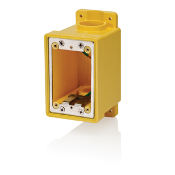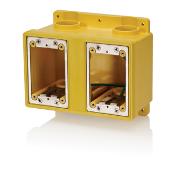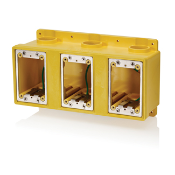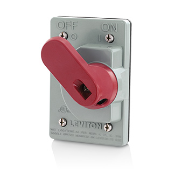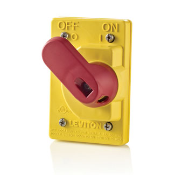600.6(A)(1), Ex. No. 2 Disconnects. (Electric Signs and Outline Lighting)
Change Summary
- A new exception was added permitting energized conductors (with warning label) in a Chapter 3 raceway or metal-jacketed cable identified for the location to be run through a sign body or enclosure to a feeder panelboard(s) located within the sign body or enclosure.
| NEC® Text |
|---|
|
600.6 Disconnects. Exception No. 1: A disconnecting means shall not be required for an exit directional sign located within a building. Informational Note: The location of the disconnect is intended to allow service or maintenance personnel complete and local control of the disconnecting means. (A) Location. Exception No. 1: A disconnect shall not be required for branch circuit(s) or feeder Exception No. 2: A disconnect shall not be required at the point of entry to a sign enclosure or sign body for branch circuit(s) or feeder conductor(s) that supply an internal panelboard(s) in a sign enclosure or sign body. The conductors shall be enclosed in a Chapter 3 listed raceway or metal-jacketed cable identified for the location. A field-applied permanent warning label that is visible during servicing shall be applied to the raceway at or near the point of entry into the sign enclosure or sign body. The warning label shall comply with 110.21(B) and state the following: “Danger. This raceway contains energized conductors.” The marking shall include the location of the disconnecting means for the energized conductor(s). The disconnecting means shall be capable of being locked in the open position in accordance with 110.25. Copyright© 2016 National Fire Protection Association (See NEC for complete text) |
Expert Analysis

For the 2014 NEC, a new 600.6(A)(1) titled, “At Point of Entry to a Sign Enclosure,” was added requiring the sign disconnect to be located at the point the feeder(s) or branch circuit(s) supplying a sign or outline lighting system enters a sign enclosure or pole. An exception to this rule was also added allowing a branch circuit or feeder to pass through a sign where enclosed in a NEC Chapter 3 listed raceway allowing the disconnecting means at each section of a large sign. Did this provision go far enough to take into consideration such things as large Las Vegas-type signs that incorporate feeder panelboards inside the sign itself at each separate section of the sign?
To ensure that this is the case, a new Exception No. 2 was added to 600.6(A)(1) for the 2017 NEC. This exception specifically addresses a sign enclosure or sign body that supplies an internal panelboard(s) in that same sign enclosure or sign body. As with the existing exception (now Ex. No. 1), the conductors shall be enclosed in a Chapter 3 listed raceway the newly allowed metal-jacketed cable identified for the location. Where this new exception goes beyond the previous exception is a requirement for a “field-applied permanent warning label” that is visible during servicing. This warning label is required to be applied to the raceway at or near the point of entry into the sign enclosure or sign body and to comply with 110.21(B). The warning label shall state the following: “DANGER – THIS RACEWAY CONTAINS ENERGIZED CONDUCTORS”
The marking on the warning label must include the location of the disconnecting means for the energized conductor(s) with this disconnecting means beingcapable of being locked in the open position in accordance with 110.25.
The provisions at 600.6(A)(1) and the exceptions allow energized circuit conductors in a Chapter 3 raceway to be run through the sign body to a feeder panelboard(s) located within the sign body. Las Vegas-type signs are typically supplied from feeders originating at the premises service equipment and terminating at these feeder panelboards within the sign. For example, each of these feeders could be rated as much as 800- or 1,200-amperes. Due to the size and location of these signs, it is desirable and/or necessary to control multiple lighting loads from within the sign body or enclosure to facilitate servicing of the sign. These feeder panelboards can be located on different levels and sections within the sign. Service personnel use the circuit breakers in the feeder panelboard(s) as a disconnecting means for branch circuits on the different levels (stories) where they are working.
Electrical safety dictates that these raceways be identified to prevent accidental or deliberate exposure to energized conductors. OSHA 1910.335(b)(1) requires the use of safety signs, safety symbols or accident-prevention tags to warn about potential electrical hazards. Warning labels and markings with similar warning of energized conductors are found in other places in the Code, such as 404.6(C) Ex.; 620.52(B); 690.5(C), etc. Equally as important, in the event of an emergency requiring de-energizing the live feeders or branch circuits passing through the sign body, the location of the disconnecting means, which is out of the line of sight and at a location other than the sign, must be known and accessible to service personnel or emergency responders. Providing a field-applied label with the location of the disconnecting means will contribute to electrical safety for service personnel as well as emergency first responders.
Outdoor Switching
Leviton offers a unique solution for outdoor switching with catalog number COVER-S. This switch cover can actuate any traditional 15-Amp to 40-Amp toggle switch including Manual Motor Starters.
- Provides NEMA (4, 4X and 12) and IEC (IP 66) watertight protection for indoor and outdoor environments in critical application areas that are routinely subject to moisture, vapor, dirt, mud and other contaminant exposure, including high-pressure washdown when used with the Wetguard® Box System
- Leviton offers a variety of covers, including this industry exclusive toggle switch cover, blank cover plates and covers to 15-Amp, 20-Amp and 30-Amp single receptacles
- Easily operated with wet and/or gloved hands, and provides OSHA compliant lockout/tagout capabilities


